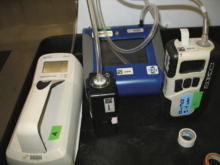Condensation particle counter


A condensation particle counter or CPC is a
Three techniques have been used to produce nucleation:
- Adiabatic expansion using an expansion chamber. This was the original technique used by John Aitken in 1888.[3]
- Thermal diffusion.
- Mixing of hot and cold gases.[2]
The most usually used (also the most efficient) method is cooling by
Condensation particle counters are able to detect particles with dimensions from 2
On the right, a diffusional thermal cooling CPC is shown in operation. In order to ensure a high vapour content, the working liquid is in contact with a hollow block of porous material that is heated. Then the humified air enters the cooler where nucleation occur. Temperature difference between the heater and the cooler determines the supersaturation, which in its turn determines the minimal size of particles that will be detected (the greater the difference, the smaller particles get counted). As proper nucleation conditions occur in the center of the flow, sometimes incoming flow is divided: most of it undergoes filtering and forms the sheath flow, which the rest of flow, still containing particles, is inserted into via a capillary. The more uniform is obtained supersaturation, the sharper is particle minimal size cutoff. During the heterogeneous nucleation process in the nucleation chamber, particles grow up to 10…12 μm large and so are conveniently detected by usual techniques, such as laser nephelometry (measurement of light pulses scattered by the grown-up particles).[4]
